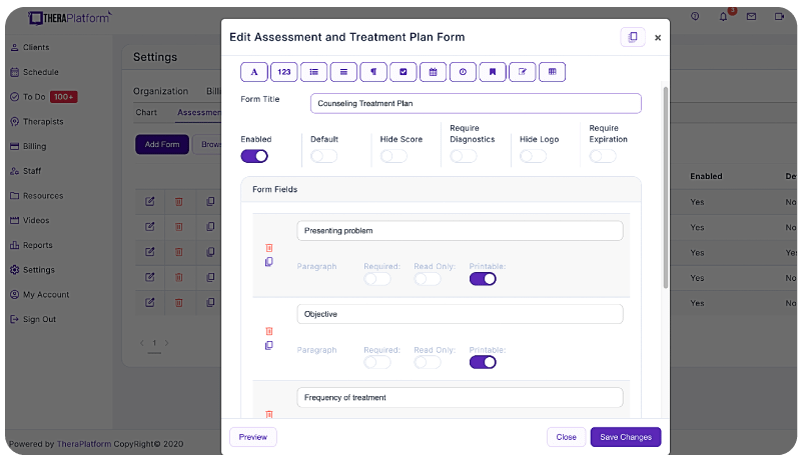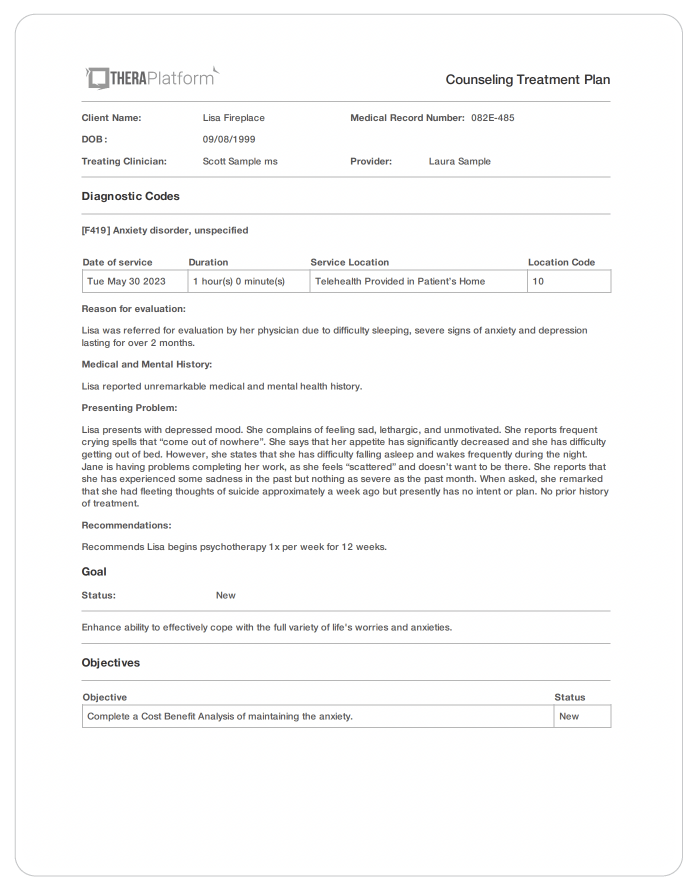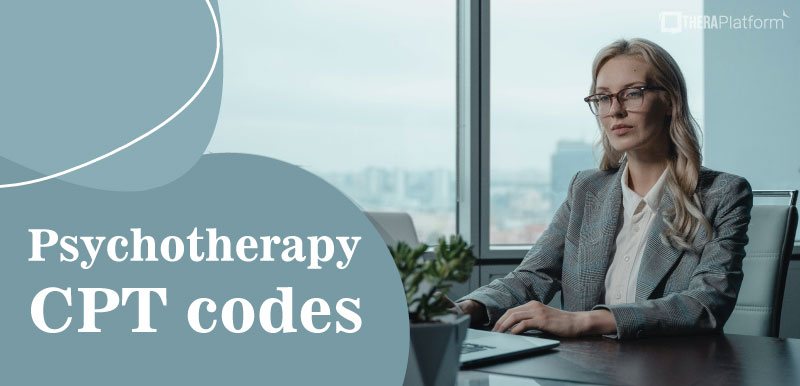Counseling treatment plan template

Counseling treatment plan templates are used in therapy settings and serve as a guide for all of those involved in the therapeutic relationship. The counseling treatment plan template directs the course of treatment by specifying the client's problems, goals, objectives, interventions, and progress in treatment. It is a living document that the therapist can use in treatment to discuss goals, progress in treatment, and client satisfaction with the therapy.
Summary
- A counseling treatment plan template helps guide therapy by outlining the client’s problems, goals, objectives, and interventions—making it easier for therapists to structure sessions and track progress.
- Using templates simplifies the planning process and ensures essential elements like DSM diagnosis, session frequency, goals, and interventions are consistently included. Download my free counseling treatment plan template.
- Goals and objectives should follow the S.M.A.R.T. framework—being specific, measurable, achievable, relevant, and time-limited—to support meaningful and trackable outcomes.
- EHR platforms like TheraPlatform integrate Wiley Treatment planners to help streamline treatment planning with customizable templates, pre-populated objectives, built-in assessments, secure storage, and digital signature tools.
Streamline your practice with One EHR
- Scheduling
- Flexible notes
- Template library
- Billing & payments
- Insurance claims
- Client portal
- Telehealth
- E-fax

Most therapists recognize the value of counseling treatment plans but struggle with writing treatment plans. Using a counseling treatment plan template for your counseling practice can simplify the process of creating a counseling treatment plan for your clients.
A counseling treatment plan template provides the structure and guidance for incorporating the important components of a treatment plan.
This article will provide you with some guidance on what to include in your plans to help in the creation of a counseling treatment plan template.
Client information in the counseling treatment plan template
The counseling treatment plan template should include basic identifying information regarding the client and the expected type of treatment.
Important information to incorporate into your counseling treatment plan template includes:
- Client name
- Date of birth
- Therapist name and credentials
- Date of the treatment plan
- Treatment modality planned (individual, couples, family, group)
- Treatment start date
- Frequency of sessions
- Estimated length of treatment
- Presenting problems (related to diagnosis)
- DSM Diagnosis
Treatment goals in the counseling treatment plan template
Counseling treatment plan templates should include a section for goals. A treatment goal is a broad description of what the client would like to achieve in therapy with you.
You can create the treatment plan in session with the client. From the discussion with the client, the goal can incorporate the client’s description of what they would like to achieve in therapy and how will the client know they have achieved this goal.
Practice Management + EHR + Telehealth
Manage more in less time in your practice with TheraPlatform

Client questions to discuss during goal development
- What would you like to see differently in your life?
- What do you want to accomplish in counseling?
- How will we know you have made changes?
- What do you want to change in your life?
- If we look 3 or 6 months down the road, what would you like to see differently from today?
When writing a treatment plan, consider including at least 2 goals. Treatment plan goals should:
- Directly relate to the diagnosis
- Include at least one goal per diagnosis
- Address decreasing symptoms and impairments identified in the assessment process
- Use positive (e.g., increase) or negative (e.g., decrease) qualifiers
- Be measurable
Watch this video to learn how to save time on therapy notes
How to write objectives in a therapy treatment plan
The treatment plan objective portion of the template describes how the client will meet the counseling goal. Objectives should be written in realistic and measurable terms and include a time frame.
You can write the objective in action language such as “Client will complete thought records at least 3 times per week for 4 consecutive weeks.” Objectives can also incorporate scores on screening tools, assessments, or other questionnaires.
For example, an objective might address the scores on the GAD-7 by saying “The client will score in the minimal anxiety range of 5-9 on the GAD-7 for 4 consecutive weeks.”
Utilizing the S.M.A.R.T. framework for writing the counseling treatment plan objectives can help you to write appropriate objectives.
Specific: The counseling goal should use clear and specific language to describe the goal. Numbers and quantifiers help to make the goal more specific.
Measurable and Meaningful: The goal should be meaningful to the client to help motivate the client to work towards the goal.
If the client does not identify with the goal, they might lack motivation to achieve it. It also needs to include measurable terms so that you know how the client has progressed towards the goal and met the goal.
Achievable: Can the client realistically take the necessary steps to reach this goal?
Relevant: The goal needs to relate directly to the client’s diagnosis and/or presenting problems for treatment.
Time-limited: Treatment plan goals should incorporate relevant time frames as a measurement of progress and meeting the goal.
Free Resources for Therapists
Click below and help yourself to peer-created resources:

Interventions on the counseling treatment plan template
The interventions section of the counseling treatment plan template discusses what the therapist will do to help the client meet the goals. The interventions should specify what type of treatment methods the therapist will implement during the sessions.
Some key points to include in your interventions are:
- Who will provide the intervention (e.g., therapist)
- Which therapeutic method (e.g., cognitive behavioral therapy)
- Specific skills from the therapeutic framework the therapist will be using (e.g., teach the client how to identify cognitive distortions used by the client)
- Any other participants in the session (e.g., parents, significant others)
- Location of the intervention, especially if not in the office (e.g., exposure-based therapy)
How to update and review the counseling treatment plan
Therapists should regularly review the treatment plan in order to evaluate and measure progress in treatment and the appropriateness of the treatment plan goals. The counseling treatment plan template should include a section to review the progress on goals.
It is a good exercise to conduct the treatment plan review collaboratively in session with the client. It can create a conversation on progress, lack of progress, or any changes that need to be made regarding the direction of treatment.
It will also provide you with relevant information on how the client feels they are progressing in therapy.
Depending on the format of your practice, the frequency of how often you review treatment plans might vary. Certain insurance and payer sources may have specific guidelines on how often they want a treatment plan reviewed and updated.
It is important to review the guidelines for any insurance plan that you accept as well as any out-of-network plans for which your clients might submit a superbill.
The update portion of the counseling treatment plan template should include:
- Measurements of progress for each goal and objective
- Evidence of progress
- Revised target date for completion, if applicable
- Any new goals or objectives
- Any necessary adjustments to treatment (ex: change in frequency, adding in family work, change in length of sessions)
- Any revisions to the estimated length of treatment
Signatures on the counseling treatment plan template
The treatment plan is not complete without the therapist and the client’s signatures along with the date of the signatures. The template should include a space for collecting these signatures. If using an electronic health record (EHR), collecting the client signature can be done electronically.
Streamline your practice with One EHR
- Scheduling
- Flexible notes
- Template library
- Billing & payments
- Insurance claims
- Client portal
- Telehealth
- E-fax

How EHR software can help with counseling treatment plan templates
Electronic health record (EHR) and practice management software, such as TheraPlatform, can help therapists save time when creating counseling treatment plans.
Benefits of using EHR for counseling treatment plan templates
Consistent template plans
Having an EHR with built-in assessments and templates for adults and children can help mental health therapists create individualized counseling treatment plans more efficiently.

Screenshot of TheraPlatform’s document library. Search TheraPlatform’s template library with built-in counseling assessments and treatment plans and edit the templates to meet your needs.
Customizable treatment plan builder
Many therapists with niche private practices can use TheraPlatform’s flexible treatment plan builder to create specialized plans. In addition to the ability to edit templates, therapists can build any template from scratch to meet their private therapy practice needs and preferences.

Screenshot of TheraPlatform treatment plan form. Use existing templates to customize your counseling treatment plan for a specific client or build your own from scratch.
HIPAA-compliant storage of counseling treatment plans
Creating and storing your counseling treatment plans in a secure, encrypted system to prevent breaches will ensure your clients’ data is safe and give you peace of mind. TheraPlatform follows bank-level security standards and provides private practices with a signed BAA.
Having a secure way to store your treatment plan is an easy decision and can be easily submitted to insurance.

Screenshot of a completed counseling treatment plan created with TheraPlatform. Therapists can quickly create high-quality counseling treatment plans using templates pre-populated with nearly 1,000 statements.
Save time with pre-populated treatment plans
Through Wiley Treatment Planner integration, creating treatment plans in TheraPlatform is a great time saver. Mental health therapists can customize treatment plans using reliable, evidence-based objectives and interventions and receive home suggestions to assign to clients.

Screenshot of Wiley Treatment Planner integration into TheraPlatform illustrating how areas like problems, behaviors, goals and objectives can be completed with pre-populated, research-based statements.
Requesting client signatures is seamless
TheraPlatform also allows counselors to request signatures from the client on treatment plans via a secure client portal.
And the process is easy.
- The clinician clicks a button to request a signature.
- The client receives an email notification that a doc is available for signature
- The client securely logs in, signs the treatment plan and the signed plan is automatically saved for the clinician under the client’s chart.
Save time with e-fax
Eliminate maneuvering between two software programs with an integrated solution like TheraPlatform that has efax integrated into its EHR. This integration saves time and lowers costs as incoming and outgoing documents like notes, and other documents are securely sent electronically.
Streamline your practice with One EHR
- Scheduling
- Flexible notes
- Template library
- Billing & payments
- Insurance claims
- Client portal
- Telehealth
- E-fax

Resources
Theraplatform is an all-in-one EHR, practice management and teletherapy solution that allows you to focus more on patient care. With a 30-day free trial, you have the opportunity to experience Theraplatform for yourself with no credit card required. Cancel anytime. They also support different industries including mental and behavioral health therapists in group practices and solo practices.
More resources
- Therapeutic alliance
- Counseling Treatment Plan
- Therapy resources and worksheets
- Therapy private practice courses
- Ultimate teletherapy ebook
- The Ultimate Insurance Billing Guide for Therapists
- The Ultimate Guide to Starting a Private Therapy Practice
Free video classes
- Free mini video lessons to enhance your private practice
- 9 Admin tasks to automate in your private practice
Sources
Riopel, L. “Goal Setting in Counseling and Therapy (Incl. Examples).” PositivePsychlogy.com. April 10, 2019. Accessed May 1, 2023
FAQs About Counseling Treatment Plan Template
Why use a counseling treatment plan template?
A template keeps treatment structured and consistent by outlining client problems, goals, objectives, and interventions. It ensures key details like diagnosis and session frequency are always included.
How often should a treatment plan be updated?
Plans are typically reviewed every 30–90 days or as required by insurance. Updates track progress, add new goals, and adjust interventions as needed.
What makes a good counseling goal?
Effective goals follow the S.M.A.R.T. framework: specific, measurable, achievable, relevant, and time-limited. This ensures goals are realistic, trackable, and meaningful for the client.



